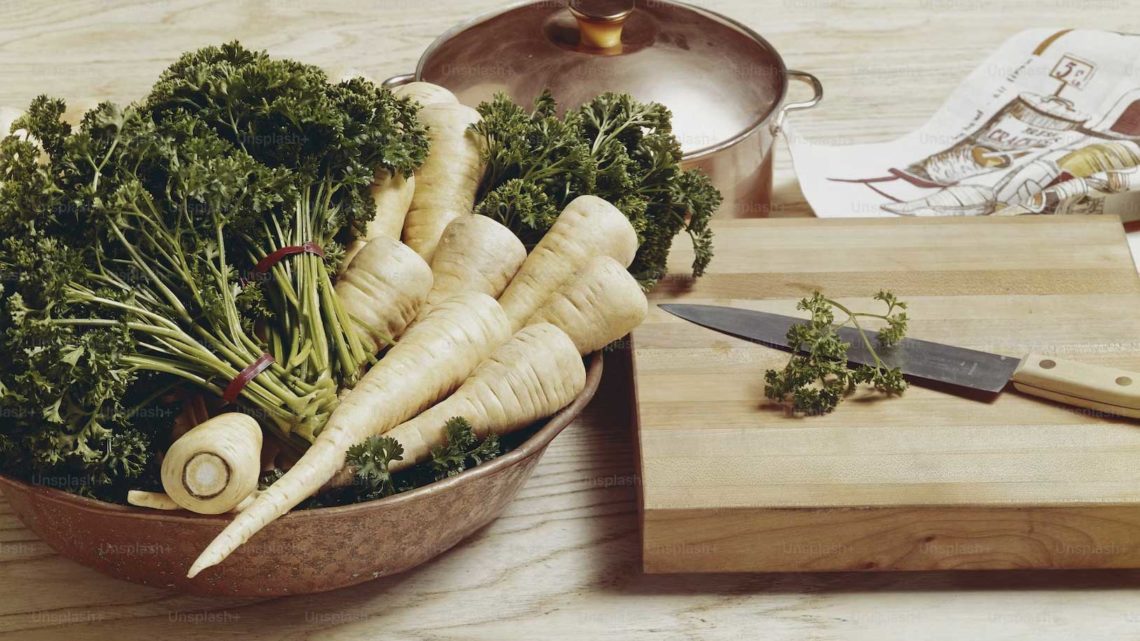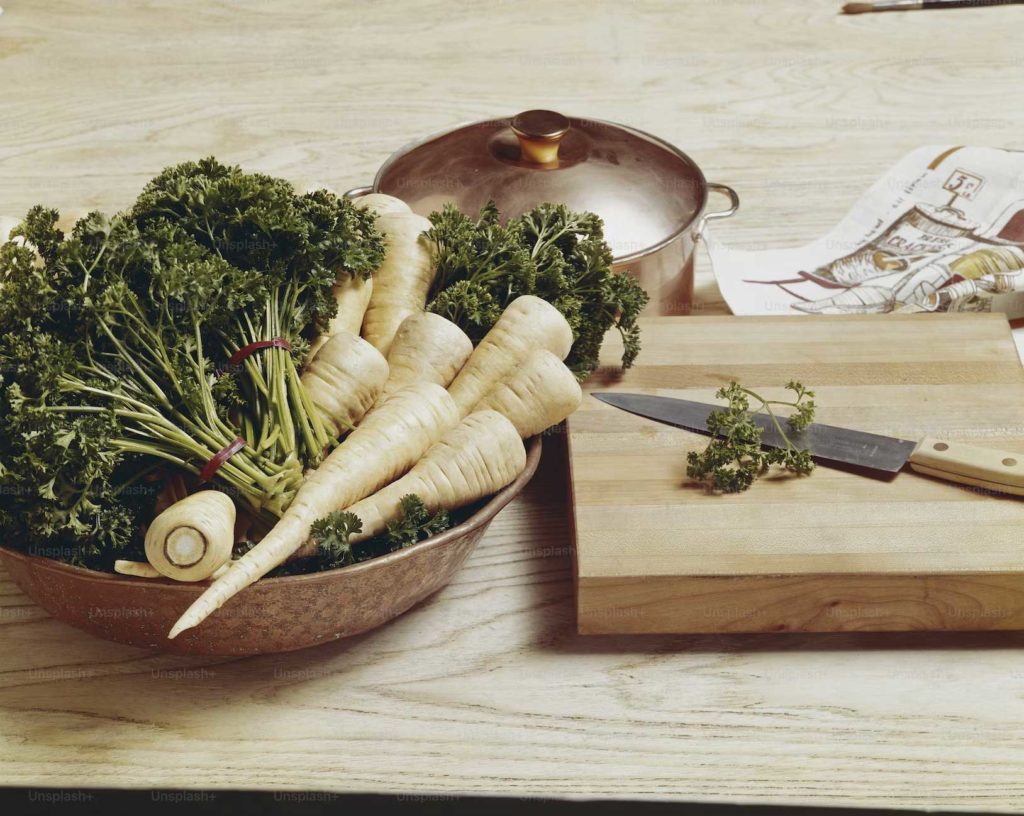
Cooking Parsnip
Parsnip, a root vegetable with a long and storied history, has been a staple ingredient in cuisines around the world for centuries. Its origin can be traced back to Eurasia, where it was cultivated and enjoyed by ancient civilizations. The parsnip plant, a member of the carrot family, is known for its distinctive ivory-colored root that offers a sweet and earthy flavor to dishes. It is a versatile ingredient that can be used in a variety of cooking methods, making it a beloved choice for both hearty winter meals and lighter summer fare.
Growing Parsnip:
Parsnips thrive in cool climates and are typically grown as a biennial crop. They require well-drained soil, preferably sandy or loamy, and a sunny location. The best time to sow parsnip seeds is in early spring or late fall, as the cooler temperatures promote their sweet flavor development. It’s important to note that parsnips have a longer growing season compared to other vegetables, often taking up to 120 days to mature. Patience is key when cultivating parsnips, as they benefit from a lengthy growing period to reach their full potential.
Harvesting Parsnip:
The ideal time to harvest parsnips is after the first frost in autumn or early winter when their flavor is at its peak. The cold temperatures convert the starches in parsnips into sugars, resulting in a sweeter taste. To harvest parsnips, loosen the soil around the roots with a garden fork or spade, being careful not to damage the delicate roots. Gently lift the parsnips from the ground, removing any excess soil, and store them in a cool, dry place until ready to use.
Cooking Parsnip:
Parsnips lend themselves to various cooking techniques, making them a versatile ingredient in the kitchen. They can be roasted to bring out their natural sweetness and caramelization, boiled and mashed for a creamy and comforting side dish, or even used in soups and stews to add depth and flavor. Additionally, parsnips can be grated and added to salads for a fresh and crisp element. Regardless of the method, parsnips offer a unique flavor profile that complements both savory and sweet dishes.

Recipes with Parsnip:
- Roasted Parsnip Fries: Cut parsnips into thin fry-like strips, toss them in olive oil, salt, and pepper, and spread them on a baking sheet. Roast in a preheated oven at 425°F (220°C) for 20-25 minutes, turning once halfway through. The result is a delightful side dish with a crispy exterior and a tender, sweet interior.
- Parsnip and Apple Soup: Sauté chopped parsnips, onions, and apples in butter until softened. Add vegetable broth and simmer until the ingredients are tender. Puree the mixture until smooth, season with salt, pepper, and a touch of nutmeg. Serve hot with a dollop of crème fraîche and a sprinkle of fresh herbs for a comforting and flavorful soup.
Nutritional Value and Health Benefits:
Parsnips are not only delicious but also offer several health benefits. They are a great source of dietary fiber, which aids digestion and helps maintain a healthy gut. Parsnips are also rich in vitamins and minerals, including vitamin C, vitamin K, potassium, and folate. Moreover, they contain antioxidants that contribute to overall well-being and may help reduce the risk of chronic diseases. However, it’s worth noting that parsnips are relatively high in natural sugars and carbohydrates, so moderation is key, especially for individuals with specific dietary requirements.
In summary, parsnip’s long history and versatile nature make it a treasured ingredient in the culinary world. Whether roasted, mashed, or blended into soups, parsnips offer a unique and satisfying flavor to a variety of dishes. Their cultivation requires patience and attention, but the reward is a sweet and earthy root vegetable that can be harvested after the first frost for optimal taste. From simple recipes like roasted parsnip fries to more elaborate creations like parsnip and apple soup, there are endless possibilities to explore with this underrated vegetable.
One delightful recipe that showcases the natural sweetness of parsnips is Honey-Glazed Parsnip Medley. Start by peeling and cutting parsnips into bite-sized pieces, along with other root vegetables like carrots and sweet potatoes. Toss the vegetables in a mixture of honey, olive oil, and a sprinkle of cinnamon. Spread them evenly on a baking sheet and roast at 400°F (200°C) for about 25-30 minutes or until tender and caramelized. The result is a beautiful medley of flavors, enhanced by the sweetness of the parsnips and the aromatic touch of cinnamon.
For a heartier and more substantial dish, consider making Parsnip and Mushroom Shepherd’s Pie. Begin by peeling and chopping parsnips into small chunks, then boil them until tender. Mash the parsnips with butter, milk, and a pinch of salt until you achieve a creamy consistency. In a separate pan, sauté mushrooms, onions, and garlic until softened. Add vegetable broth, soy sauce, and your choice of herbs like thyme or rosemary for extra flavor. Simmer until the liquid has reduced and the mixture has thickened. Transfer the mushroom filling into a baking dish, top it with the parsnip mash, and bake at 375°F (190°C) for 25-30 minutes or until the top is golden brown. The result is a comforting and satisfying vegetarian twist on a classic dish.
When it comes to the nutritional value of parsnips, they offer an array of health benefits. They are low in calories and fat while being a good source of vitamins and minerals. Parsnips are particularly rich in dietary fiber, which aids in digestion, regulates blood sugar levels, and promotes a feeling of fullness. They also contain antioxidants that help strengthen the immune system and protect against various diseases. However, due to their natural sugar content, individuals with diabetes or those following a low-carb diet should consume parsnips in moderation.

–
Experience World Food is your one stop to find your food tour.